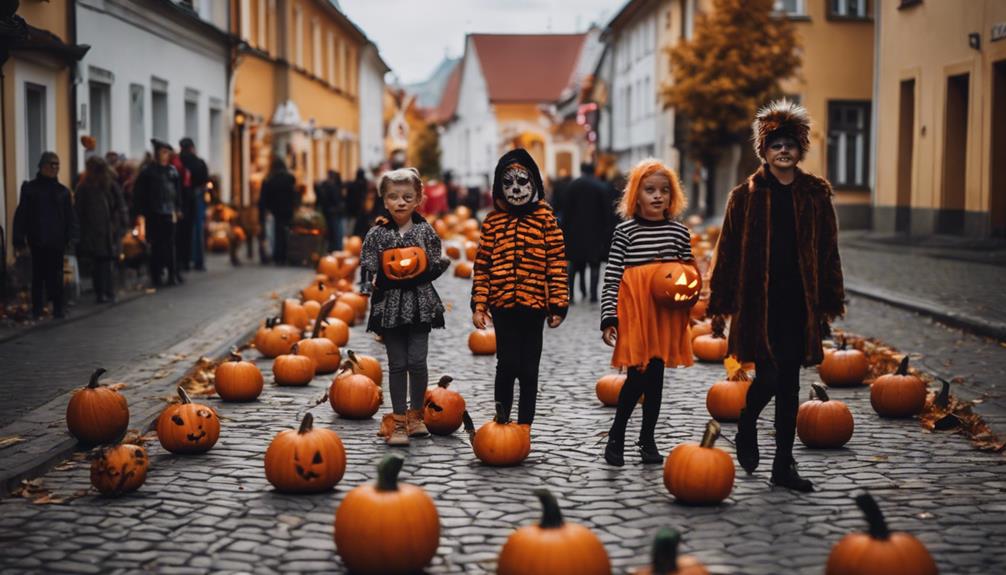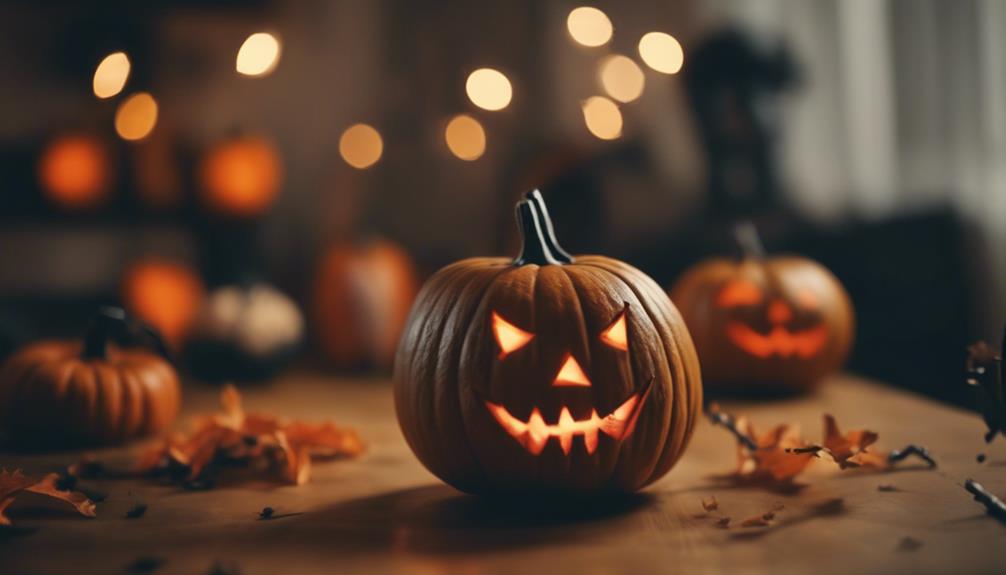In Israel, Purim reflects deep religious and cultural roots, with traditions like reading the Megillah, giving charity, and wearing costumes inspired by Jewish history and faith. Halloween, however, is more secular, centered around costumes, decorations, and entertainment without strong religious ties. While Purim promotes community bonding and cultural continuity, Halloween emphasizes fun and creativity. If you want to understand how these celebrations really differ in Israel, there’s more to discover below.
Key Takeaways
- Purim in Israel is a religious and cultural holiday with rituals like Megillah readings and charity, while Halloween is largely secular and entertainment-focused.
- Purim costumes in Israel often depict Jewish history and biblical figures, emphasizing cultural and religious themes.
- Purim celebrations include community gatherings, festive meals, and acts of charity, contrasting with Halloween’s trick-or-treating and themed parties.
- Purim reinforces Jewish continuity, faith, and cultural identity in Israel, whereas Halloween emphasizes secular fun and creativity.
- The religious significance of Purim makes it a meaningful holiday in Israel, unlike Halloween’s primarily secular and entertainment-driven observance.

While Halloween has become increasingly popular worldwide, Israel’s traditional holiday of Purim remains deeply rooted in its Jewish culture. As you observe Purim, you’ll notice that it’s more than just a festive occasion; it’s a vibrant expression of cultural celebrations and religious observances that have been passed down through generations. Unlike Halloween, which is largely driven by secular customs like costumes and trick-or-treating, Purim intertwines communal joy with spiritual significance. You’ll find that the holiday emphasizes reading the Megillah, giving charity to the needy, and sharing festive meals, all central to its religious observances.
Purim is a vibrant, faith-filled celebration rooted in Jewish culture and tradition.
During Purim, you’re encouraged to dress up in costumes, but these often reflect characters from Jewish history, biblical figures, or creative interpretations of religious themes. This tradition of wearing costumes allows you to participate actively in the celebration, blending fun with reverence. It’s common to see children and adults alike donning masks and costumes that symbolize the triumph of good over evil, reinforcing the holiday’s religious message. These cultural celebrations serve as an educational tool, helping to keep the history and lessons of Purim alive in a lively, engaging way.
You might also notice that community gatherings play a crucial role in Purim. Synagogues and community centers host special readings of the Megillah, where you’re encouraged to cheer, boo, or make noise to drown out Haman’s name—an interactive part of the religious observance. This communal aspect strengthens bonds and reminds you of the importance of unity and resilience in Jewish tradition. Additionally, giving mishloach manot (food gifts) and matanot la’evyonim (charitable donations) highlight the holiday’s focus on charity and caring for others, making it a deeply meaningful time beyond just the festivities.
While Halloween’s appeal often lies in its spooky costumes and thematic decorations, Purim’s cultural celebrations and religious observances are rooted in history and faith. You’re encouraged to reflect on themes of survival, faith, and hope, which resonate through the rituals and customs. This contrast helps you appreciate how each holiday caters to different cultural values—one secular and entertainment-driven, the other spiritual and community-centered. Whether you’re dressing up in costumes that honor Jewish history or participating in traditional prayers and acts of kindness, Purim offers a unique way to connect with your heritage and faith, making it an enduring and meaningful celebration in Israel’s rich cultural landscape. Additionally, kosher dietary laws are often observed during the festive meals, further emphasizing the holiday’s religious significance.
Frequently Asked Questions
How Do Israeli Children Celebrate Purim and Halloween Differently?
You’ll notice that children celebrate Purim and Halloween quite differently. During Purim, kids wear colorful Purim costumes, often representing characters from Jewish history or folklore, and participate in lively festivities, including giving gifts, reading the Megillah, and enjoying festive meals. For Halloween, children dress in spooky Halloween costumes, like ghosts or witches, and go door-to-door for candy. The focus on cultural traditions makes each celebration unique and exciting.
What Are the Historical Origins of Halloween in Israel?
Halloween in Israel has roots in ancient festivals and modern cultural influences. Originally, it didn’t exist there, but Western practices brought by immigrants and globalization introduced it as a celebration of costumes and trick-or-treating. You might see Halloween blend with local customs, reflecting a mix of ancient festivals and contemporary influences, creating a unique cultural experience. It’s a recent addition shaped by international trends rather than traditional Israeli or Jewish history.
Are Costumes for Purim and Halloween Culturally Similar or Distinct?
Did you know that over 75% of people celebrate costume traditions during these festivals? When comparing Purim and Halloween, their costumes are quite distinct. Purim costumes emphasize cultural and religious significance, often portraying biblical characters or themes, while Halloween costumes lean toward spooky or pop culture figures. These traditions reflect their unique cultural significance—Purim’s focus on community and history versus Halloween’s entertainment and self-expression.
How Do Israeli Communities Perceive Halloween Compared to Purim?
You might notice that Israeli communities view Halloween differently from Purim regarding cultural acceptance and community engagement. Purim, deeply rooted in tradition, fosters strong community participation and celebrates Jewish history. Halloween, however, is often seen as a more commercial, Western holiday with mixed acceptance. Some communities embrace it for fun, while others view it with skepticism, leading to diverse perceptions about its role in Israeli society.
Are There Any Legal Restrictions on Halloween Celebrations in Israel?
Think of Halloween in Israel as a delicate dance—each step carefully measured. While there’s no blanket ban, legal restrictions and celebration regulations shape how you can observe the holiday. Authorities may limit certain activities, like costume parades or parties, especially in public spaces. You should stay informed about local rules to avoid stepping out of line. Ultimately, you can celebrate, but with respect for legal boundaries that keep the rhythm in check.
Conclusion
As you consider the vibrant traditions of Purim and Halloween, you realize there’s more than meets the eye. Each holiday carries its own history, meaning, and mystery, inviting you to explore deeper cultural roots. Will you see these celebrations as mere costumes and candy, or will you uncover the stories that give them true significance? The choice is yours—what secrets might you discover as you explore further into these fascinating festivities?










